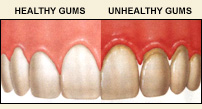
545 Rue de Saint Jovite,
Mont-Tremblant (Québec)
J8E 2Z9, Canada
Pour le courrier, écrire à :
545 Rue de Saint Jovite, CP 4510
Mont-Tremblant (Québec)
J8E 1A1, Canada
Periodontal disease
Gum diseaseGum diseases, better known as periodontal diseases, are among the most common on a global scale. It is said that 70% of the planet’s population has this pathology in one form or another. Furthermore, nearly 900 million people apparently suffer from a severe form of periodontal disease, which is a potential health risk, namely leading to certain serious health problems. |
WHO dataAccording to recent data collected by the World Health Organization (WHO), 10 to 15% of the world’s population, between 600 and 900 million people, suffer from a severe form of periodontal disease. Despite the publication of studies in recent years that potentially link periodontal diseases to other serious health problems, this disease and its impact on general health and quality of life seems to have fallen on deaf ears with regard to the media, government health authorities and health care professionals. |
What are periodontal diseasePeriodontal diseases are chronic bacterial infections that deteriorate the supportive tissue of the teeth: the soft tissue (gums, ligaments) and the hard tissue (cementum, alveolar bone). These infections are mainly caused by plaque buildup (bacterial film) on the surface of the teeth, which results in inflammation of the tissue that supports the teeth. Without treatment, this tissue (including the alveolar bone) can continue to break down, ending in tooth loss. Gingivitis is the most benign form of this pathology, with only the gums being affected. The gums become red, swollen and may bleed easily. In this phase of the disease, the person may feel slight or no discomfort. Gingivitis is reversible if treated by a professional and if the dental care is accompanied by good oral hygiene. Periodontitis is a progressive form of periodontal disease characterised by inflammation and gradual destruction of the tooth’s root system, that is, its support tissue. An x-ray radiography will reveal the formation of pockets between the root and gum, called periodontal pockets. Fortunately, there are effective treatments for periodontitis. |
Symptoms and treatment of Periodontal diseaseGums that are red, swollen and bleed over a long period, sensitivity and bad breath are all signs of gum disease. As the symptoms are painless, many people do not realize that they are in the beginning stage of gum disease: gingivitis.
When prompt action is taken, good oral hygiene can stop gingivitis from progressing. More advanced forms of gum disease, periodontitis, require the care of a dental professional who can plane the root and remove plaque and tartar that have accumulated under the gum line. Surgery may be required when the gums and bone tissues are damaged in the more advanced stages of the disease. |
Link between periodontal diseases and certain general pathologiesIn the past several years, a number of studies have demonstrated that after a bleeding episode (from chewing, trauma, etc.), bacterias in the oral cavity enter the bloodstream. The body’s physiological response is to secrete chemical mediators like cytokines that have a potential impact on health. In some cases, the prolonged and repeated presence of bacterias in the blood can trigger or increase the risk of developing serious health problems, such as cardiovascular disease, diabetes, pneumonia and other respiratory problems, stroke and complications during pregnancy. |


Poser une question ou laisser un commentaire